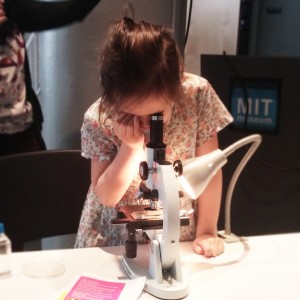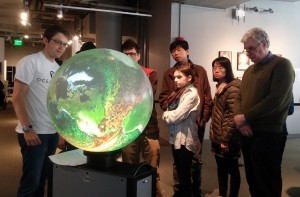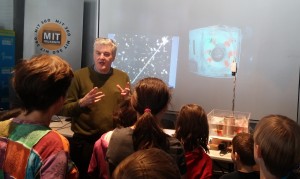PAOC Spotlights
Diving into Ocean Science at the 2015 Cambridge Science Festival
Just in time for Earth Day, Oceans at MIT was thrilled to participate in the Cambridge Science Festival Ocean’s Day hosted April 23, 2015 at the MIT Museum.
***
Cambridge is a hub for science, technology, and innovation, so it’s not surprising that the city hosts an annual science festival showcasing cutting edge research, while making it fun and accessible for residents. The festival offers a wide range of lectures, debates, exhibitions, concerts, plays, and workshops over ten days, many of which are kid-friendly. Last week, professors, post-docs, and graduate students in the Department of Earth, Atmospheric, and Planetary Sciences (EAPS) volunteered for Oceans Day, where they taught visitors about marine microbes, physical oceanography, climate and weather with dazzling displays and experiments.
Phytoplankton
 “What are they?” asked a young boy, pointing to the small creatures dancing on a large screen. Mick Follows, an associate professor in EAPS and leader of the MIT Darwin Projectexplained that what the boy was seeing were phytoplankton, microscopic organisms that play an important role in ocean and freshwater ecosystems. “Do they fight?” he inquired, eliciting a chuckle from Follows. While phytoplankton don’t fight, they are devoured by predators such as copepods—aquatic crustaceans which were also darting around the screen.
“What are they?” asked a young boy, pointing to the small creatures dancing on a large screen. Mick Follows, an associate professor in EAPS and leader of the MIT Darwin Projectexplained that what the boy was seeing were phytoplankton, microscopic organisms that play an important role in ocean and freshwater ecosystems. “Do they fight?” he inquired, eliciting a chuckle from Follows. While phytoplankton don’t fight, they are devoured by predators such as copepods—aquatic crustaceans which were also darting around the screen.
Biological Oceanographer Darcy Taniguchi collected the organisms earlier that morning from the Charles River. She works with Follows researching how planktons’ sizes affect their interactions in the ocean. With the help of a compound light microscope and digital camera, they projected the magnified view of the petri dish that the phytoplankton now called home onto a white screen. Another smaller microscope was available for visitors to view slides of the microscopic marine creatures. “When you go kayaking in the river, you’re surrounded by phytoplankton,” Taniguchi said. “If you’ve gone swimming in the river or in another body of water that’s not a pool, you’ve probably swallowed some as well. It’s amazing to think of the bustling life around us that we can’t see.”
iGlobe

Twenty five years ago, NASA’s Voyager 1 captured one of the most profound images of Earth ever taken—the pale blue dot. Today we are able to visualize Earth and its natural processes, from ocean circulation to the atmosphere and climate change, thanks to a different dot. The iGlobe is a large, computerized sphere used for displaying images, movies and real-time data of atmospheric storms, climate change, and ocean temperature among other things.
Scores of visitors gathered around the globe, marveling at the glowing technology. Controlled by an iPad, anyone can quickly change Earth’s rotation or orientation with the swipe of a finger, as well as view over 250 movies of the ocean, weather, and climate. “Viewers can begin to understand the astronaut’s sense of awe at seeing Earth from space, can begin to feel the interconnectedness of the world’s atmosphere, ocean and ecosystems and realize the importance of understanding climate science and climate change,” according to a description of the iGlobe/MIT Projectled by MIT Oceanographer Glenn Flierl.
Funded by the National Science Foundation, the project allows researchers and educators to tap into data archives on the web to learn more about Earth’s climate and prepare this customizable educational tool for schools and outreach events like the Cambridge Science Festival.
Weather in a Tank
 While the iGlobe displayed data simulations of atmospheric circulation, an experiment set up nearby, involving swirling tanks of colored water and buckets of ice, made the physics behind it easier for visitors to grasp. EAPS scientists call it ‘Weather in a Tank’ and it is a signature feature of education in the department. For the Cambridge Science Festival, EAPS faculty member John Marshall, helped by lots of students and postdocs, demonstrated atmospheric weather systems—specifically how Earth’s rotation creates systems that affect the temperature difference between the warm tropics and cold poles. To create a cold pole, a bucket of ice is placed in the center of the tank, forming a temperature gradient in the water—colder near the bucket (pole) and warmer near the edges (equator). The tank’s rotation created small currents called eddies, which closely resemble weather patterns and can be seen with just a few drops of food coloring. Marshall explained the physics of these eddies and how they moderate temperature as the red and green currents swirling around the tank captivated visitors’ attention.
While the iGlobe displayed data simulations of atmospheric circulation, an experiment set up nearby, involving swirling tanks of colored water and buckets of ice, made the physics behind it easier for visitors to grasp. EAPS scientists call it ‘Weather in a Tank’ and it is a signature feature of education in the department. For the Cambridge Science Festival, EAPS faculty member John Marshall, helped by lots of students and postdocs, demonstrated atmospheric weather systems—specifically how Earth’s rotation creates systems that affect the temperature difference between the warm tropics and cold poles. To create a cold pole, a bucket of ice is placed in the center of the tank, forming a temperature gradient in the water—colder near the bucket (pole) and warmer near the edges (equator). The tank’s rotation created small currents called eddies, which closely resemble weather patterns and can be seen with just a few drops of food coloring. Marshall explained the physics of these eddies and how they moderate temperature as the red and green currents swirling around the tank captivated visitors’ attention.
***
This was Oceans at MIT’s third time participating in the Cambridge Science Festival. We enjoyed teaching the public about the atmosphere and ocean, and in the process learned many things ourselves. Other exhibits at Ocean’s Day included 3D printing model ship parts and coralfor use in aquariums, building robotic marine vehicles, a “What Microbe Are You?” quiz (we’re Salinspora tropica), demonstrations of tying ship knots, and WHOI’s REMUSautonomous underwater vehicles.
Oceans at MIT is dedicated to reporting on MIT and WHOI’s efforts to understand, protect, and harness the world’s oceans. Connect with us on Facebookand Twitterto stay up to date on the latest stories. See you next year!